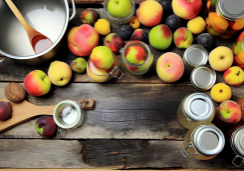9 Best Reliable Stir-Fry Techniques for Vegetables
Just as a master painter knows their brushes and colors, you too must become acquainted with the tools and techniques that transform simple vegetables into a stir-fry masterpiece.
Your canvas awaits: a well-seasoned wok, the freshest produce you can find, and a handful of reliable methods. You'll need to select the right oil that can handle the heat without smoking out your kitchen.
Perfecting the swift dance of stir-frying demands not only precision but also an understanding of timing—knowing exactly when to add each vegetable to the mix to maintain their vibrant colors and crisp textures.
As you stand at the threshold of culinary creativity, remember that the secrets to unlocking the full potential of your ingredients lie within these nine techniques. With them, you will elevate your stir-fries from mere side dishes to the stars of the dining table, leaving everyone wondering about the finesse behind your flavorsome feats.
Choose the Right Wok
Selecting a carbon steel wok ensures quick and even heating, essential for perfect stir-fry results. The magic of a well-executed stir-fry lies in the wok hei, the unique, smoky flavor that's a hallmark of Chinese cooking. Achieving that requires a wok that can handle high smoke points without losing its composure. Carbon steel is your ally here, responding rapidly to temperature changes and distributing heat uniformly.
You'll want to opt for a wok with a flat bottom to sit securely on your modern stovetop. This stability is key when you're tossing vegetables and ensures the heat is concentrated where it's needed most. A wok with two handles also comes in handy, giving you the leverage to flip and stir with the grace of a stir-fry connoisseur.
Don't be tempted by just any nonstick coating; it can degrade at the high temperatures needed for proper stir-fry technique. Instead, a well-seasoned carbon steel wok becomes naturally nonstick over time, offering both performance and ease of cleaning.
Lastly, size matters. Your wok should be spacious enough to prevent crowding, allowing each piece of vegetable to sear and sizzle to perfection. With these considerations in mind, you're on your way to stir-fry mastery.
Preheat the Wok Properly
Before you toss in those vibrant veggies, be sure your wok is properly preheated. Crank up the heat to the max and wait until you see wisps of smoke signaling it's searing hot, a step that's crucial for that authentic stir-fry sear.
If you're using a sauté pan instead, keep in mind that while it can work, nothing beats the fierce heat of a well-heated wok to give your vegetables that perfect, crisp-tender bite.
Achieving Optimal Wok Temperature
To unlock the full potential of your stir-fry, start by heating your wok until it's smoking hot, ensuring those signature flavors can develop properly. Achieving a hot wok is critical; place it over high heat and let it sit for 5 to 10 minutes. You'll know it's ready when a faint wispy smoke rises, signaling a dry wok primed for cooking. Don't have a wok? A sauté pan can suffice—just make sure it's equally preheated.
Once it's adequately heated, add a small amount of oil, swirling it around to coat the center of the wok. This step is vital to prevent sticking and to cool down the wok slightly, creating the ideal cooking surface for your vegetables.
Importance of Wok Preheating
Having understood the process of heating your wok, let's explore why proper preheating is crucial for the art of stir-frying.
Getting your wok hot enough is paramount; it ensures that the high temperatures necessary for an authentic experience are reached. Unlike a sauté pan, a wok requires at least 5 to 10 minutes over the highest flame to evenly cook your veggies without sticking.
As you preheat, the wok starts to smoke slightly—this is your cue that it's ready for those healthy drizzles of peanut, safflower, avocado, or sunflower oil.
This preheating ritual doesn't just cook your food; it unlocks that coveted smoky flavor known as 'wok hei', elevating your stir-fry from simple sautéed vegetables to a dish bursting with complexity and depth.
Optimal Oil Selection
You'll want to choose your stir-fry oil as carefully as you select your fresh veggies.
Reach for high smoke point oils like peanut or avocado to avoid any burnt flavors while locking in a quick sear.
Keep flavors crisp and clean with neutral oils, or get creative and mix oils like sesame and peanut for an added twist.
Choosing Healthy Fats
When stir-frying your favorite veggies, selecting an oil with a high smoke point, such as avocado or light olive oil, is key to avoiding burnt flavors and maximizing health benefits. These oils not only withstand the high heat essential for a quick sear but also deliver on the promise of healthy fats.
Renowned stir-fry expert Grace Young suggests a drizzle of sesame oil or a splash of soy sauce can add depth to your dish without overwhelming it.
High Smoke Point Oils
Building on the importance of healthy fats, it's essential to select oils with high smoke points for your stir-frying endeavors. Oils such as avocado, light olive, or canola oil are ideal choices. These oils ensure that your vegetables are cooked perfectly without any undesirable burnt taste.
When you're wielding your wok with the prowess of a Chinese chef, the right cooking oil can be your secret weapon. High smoke point oils stand up to the intense heat required, maintaining stability over 400°F (204°C). This means no flavor changes or harmful compounds sneak into your vibrant veggies.
Heed these cooking tips for a flawless stir-fry: choose your oil wisely to preserve the 'Breath of The Wok'—that elusive, smoky essence revered in stir-fry dishes. Your palate will thank you for the attention to detail, yielding exquisitely textured and flavored results.
Mastering the Stir-Fry Order
To achieve the perfect stir-fry, start by sizzling longer-cooking ingredients like onions and sliced mushrooms before adding quicker-cooking veggies to the mix. This ensures that each component is cooked just right. As you 'Stir-Frying to the Sky's Edge,' keep in mind the following order:
- Cook the Vegetables:
- Begin with the ones that need more time to soften.
- Add leafy greens or delicate veggies later to avoid overcooking.
- Aim for crisp, vibrant results, not mushy disappointments.
- Meat Matters:
- Cut it into small pieces for uniform cooking.
- Sear it first, then set it aside on a plate.
- Add it back towards the end to reheat and integrate flavors.
- Sauce and Seasoning:
- Prepare a cornstarch slurry to thicken your sauce.
- Coat the food with this mixture for glossy, flavorful bites.
- A splash of sesame oil can be added as a finishing touch.
Timing is crucial in stir-frying. By adding ingredients in stages, you ensure that each gets the cooking time it needs without compromising the dish's overall texture and taste.
Cutting Vegetables Uniformly
Achieving an even stir-fry starts with your knife skills. By cutting all your vegetables into uniform sizes, you'll ensure they cook evenly and at the same pace. Uniformity in size and shape isn't just about aesthetics; it's pivotal for the textures and flavors to meld perfectly in your dish.
For example, slice snow peas and snap peas on the diagonal, so they've more surface area to absorb the heat quickly. Green beans should be trimmed and cut to match their length for a harmonious bite.
When dealing with leafy greens, roll them up and slice them into ribbons to achieve a consistent thickness that will wilt down nicely. Bell peppers, on the other hand, should be julienned or diced depending on your preference, but always keep the pieces similar in size to your other veggies.
Don't underestimate the power of a sharp knife and a steady hand for precise cuts. If you're not confident in your knife skills, consider using a mandoline for slices that are uniform every time.
High Heat, Quick Cooking
Once your vegetables are prepped and ready, crank the heat up high under your wok until it's just shy of smoking, setting the stage for a quick, vibrant stir-fry. High heat is crucial—it seals in those fresh flavors and textures that you're after. But with great heat comes great responsibility, and you'll need to give your stir-fry your full attention to prevent any mishaps.
Here are some key techniques to keep in mind:
- Oil and Heat
- Drizzle a small amount of cooking oil; its high smoke point is your ally against burning.
- Wait for the oil to shimmer, an indicator that your wok is hot enough.
- Quick Cooking
- Toss your vegetables in and keep them moving—stir constantly to encourage even cooking without charring.
- Remember, speed is of the essence; we're talking minutes, not hours.
- Batch Success
- Cook in batches if necessary to avoid overcrowding, ensuring every piece gets the high heat it deserves.
- This method keeps them crisp, colorful, and evenly cooked.
Embrace the sizzle and pop as your vegetables dance in the wok. This is the art of quick cooking with high heat, where timing is everything, and your vegetables emerge as the perfect stir-fry stars.
Implementing the Toss Technique
Mastering the high heat of your wok is just the beginning; now let's focus on refining your toss technique to ensure every vegetable is perfectly coated and cooked.
Imagine your stir-fry as a lively dance of vibrant colors, each vegetable a dancer leaping at the command of your spatula. You're not just cooking; you're orchestrating an edible symphony.
Begin by drizzling oil around the heated rim of the wok, allowing it to cascade down to create a non-stick surface. Introduce your vegetables to this sizzling stage, and with a confident hand, employ the toss technique. Lift and flip the ingredients with a quick, yet controlled motion—think of it as 'Stir-Frying to the Sky's Edge.' Your spatula is your baton, gently mixing the vegetables without crushing their spirit.
As you toss, aim for an upward and outward arc, ensuring the heat kisses every piece evenly. This is about more than just mixing; it's about giving each vegetable a chance to shine, its flavors melding and its edges caramelizing to perfection.
Balancing Flavors With Sauces
To elevate your stir-fry, consider the art of balancing flavors using a medley of sauces, each bringing its unique notes to create a harmonious blend that enhances the natural taste of your vegetables and proteins. A good stir-fry isn't just about the sizzle; it's about the symphony of tastes that dance on your palate.
Experiment with a variety of sauces:
- Soy sauce for umami depth
- Oyster sauce for a sweet and savory balance
- Shaoxing wine to impart a subtle richness
Adjusting the sauce's sweetness, saltiness, and acidity is key to complementing the crisp freshness of bean sprouts or the earthiness of mushrooms. A glossy, well-coated finish is essential for a good stir-fry, and you can achieve this by whisking in a cornstarch slurry.
Aromatic elements to add:
- Minced garlic for a pungent kick
- Sesame oil for a nutty fragrance
- Sesame seeds for a delightful crunch
Don't shy away from a touch of heat; a drizzle of sriracha or a sprinkle of red pepper flakes can elevate the entire dish.
Balancing flavors with sauces:
- Adjust to taste while cooking
- Consider the main ingredients' flavor profiles
- Finish with a sprinkle of fresh herbs or extra sesame seeds for complexity
Cleaning and Maintenance Tips
After crafting your flavorful stir-fry, it's crucial to clean and maintain your wok properly to ensure its longevity and performance. As a home cook, you've mastered the art of stir-fry techniques, sizzling vegetables to perfection. Now, it's time to care for your trusty wok with a few simple cleaning and maintenance tips.
First, tackle cleaning immediately after use; this prevents food from sticking and hardening. Use a soft sponge to gently scrub away remnants—abrasive tools are a no-go as they can strip the wok's seasoning. If stubborn bits cling on, soak the wok in warm water for a short time, then try again.
Once clean, dry your wok thoroughly. Moisture is the enemy, inviting rust to erode your wok's surface. Heat it over a low flame to ensure every drop evaporates, or pat it dry with a towel, then let it rest at room temperature.
Re-season your wok regularly to reinforce its non-stick surface. 'Stir-Frying to the Sky's Edge' suggests heating oil in the wok, swirling it to coat, then discarding and wiping it clean. This ritual keeps your wok ready for your next veggie extravaganza.
Frequently Asked Questions
What Is the Secret of Stir-Frying Vegetables?
You'll unlock stir-frying success by mastering heat control, picking the right oil, and honing your cutting techniques. Select veggies wisely, layer flavors skillfully, and cook them in the correct order for perfect results.
How to Stir Fry Vegetables Correctly?
To stir-fry veggies right, choose high smoke point oils, manage your wok's heat, and cut veggies evenly. Sequence ingredients thoughtfully, use the right utensil, and balance flavors for a perfect stir-fry.
What Are the 3 Rules of Stir-Frying?
You'll master stir-frying by heating your wok until it smokes, quickly moving ingredients with the right utensils, and prepping with high heat in mind. Choose your oil wisely, and follow the proper sequence.
What Is the Key to Making a Successful Stir-Fry?
You'll nail stir-frying by mastering heat control, prepping ingredients, layering flavors, choosing the right oil, perfecting the cooking sequence, and seasoning your wok. It's all about the sizzle and swift action!
Conclusion
Now you've got the chops to stir-fry like a pro! Remember, grab that perfect wok, get it smoking hot, and keep those veggies snappy.
Your stir-fry game's all about speed and heat, so toss quickly, season boldly, and savor the vibrant flavors you've unleashed.
Keep your wok well-loved, and it'll be your trusty sidekick for countless meals.
Go on, stir up some culinary magic and watch your kitchen come alive with every sizzle and sear!










